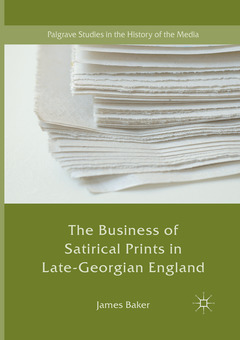Description
The Business of Satirical Prints in Late-Georgian England, 1st ed. 2017
Palgrave Studies in the History of the Media Series
Author: Baker James
Language: English
Keywords
Early modern; Publishing; European history; Satire; Social history; eighteenth century; commerce; Georgian
Approximative price 94.94 €
In Print (Delivery period: 15 days).
Add to cart
The Business of Satirical Prints in Late-Georgian England
Publication date: 08-2018
Support: Print on demand
Publication date: 08-2018
Support: Print on demand
The Business of Satirical Prints in Late-Georgian England
Publication date: 04-2017
Support: Print on demand
Publication date: 04-2017
Support: Print on demand
Description
/li>Contents
/li>Biography
/li>Comment
/li>
This book explores English single sheet satirical prints published from 1780-1820, the people who made those prints, and the businesses that sold them. It examines how these objects were made, how they were sold, and how both the complexity of the production process and the necessity to sell shaped and constrained the satiric content these objects contained. It argues that production, sale, and environment are crucial to understanding late-Georgian satirical prints. A majority of these prints were, after all, published in London and were therefore woven into the commercial culture of the Great Wen. Because of this city and its culture, the activities of the many individuals involved in transforming a single satirical design into a saleable and commercially viable object were underpinned by a nexus of making, selling, and consumption. Neglecting any one part of this nexus does a disservice both to the late-Georgian satirical print, these most beloved objects of British art, and to the story of their late-Georgian apotheosis ? a story that James Baker develops not through the designs these objects contained, but rather through those objects and the designs they contained in the making.
Acknowledgements.- List of Tables/Figures.- Chapter 1: Beginnings.- Chapter 2: Scandal.- Chapter 3: Production.- Chapter 4: People.- Chapter 5: Trade Networks.- Chapter 6: The Physical Marketplace.- Chapter 7: The Shops.- Chapter 8: Satiric Stock.- Bibliography.- Index
James Baker is Lecturer in Digital History at the University of Sussex, UK. He specialises in the history of the printed image in the long eighteenth century, is a fellow of the Software Sustainability Institute, and has held positions at the British Library, the Paul Mellon Centre for Studies in British Art, and the University of Kent, UK.
Provides a scholarly account of the people and the processes involved in bringing late-Georgian satirical prints to market Explores how the processes of how these prints were made, and sold, constrained the satiric content these objects contained Makes a significant contribution to a growing and important body of work which examines print culture and early-modern life
© 2024 LAVOISIER S.A.S.




